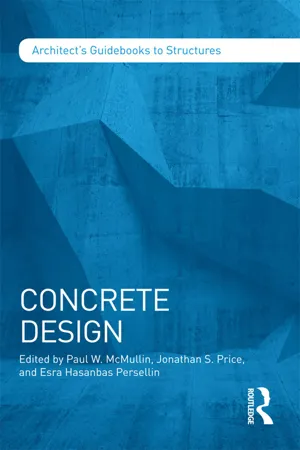
Concrete Design
Paul McMullin, Jonathan Price, Esra Hasanbas Persellin, Paul W. McMullin, Jonathan S. Price, Esra Hasanbas Persellin
- 338 pagine
- English
- ePUB (disponibile sull'app)
- Disponibile su iOS e Android
Concrete Design
Paul McMullin, Jonathan Price, Esra Hasanbas Persellin, Paul W. McMullin, Jonathan S. Price, Esra Hasanbas Persellin
Informazioni sul libro
Concrete Design covers concrete design fundamentals for architects and engineers, such as tension, flexural, shear, and compression elements, anchorage, lateral design, and footings. As part of the Architect's Guidebooks to Structures Series it provides a comprehensive overview using both imperial and metric units of measurement. Written by experienced professional structural engineers Concrete Design is beautifully illustrated, with more than 170 black and white images, contains clear examples that show all design steps, and provides rules of thumb and simple tables for initial sizing. A refreshing change in textbooks for architectural materials courses, it is an indispensable reference for practicing architects and students alike. As a compact summary of key ideas it is ideal for anyone needing a quick guide to concrete design.
Domande frequenti
Informazioni
Chapter 1
The National Assembly Building, Dhaka, Bangladesh (Sher-e-Bangla Nagar Capital)
1.1 Introduction
1.1.1 Politics
1.1.2 The Dhaka Commission
1.2 Design
1.2.1 The Program
1.2.2 The Design Team
1.2.3 Timeline

1.2.4 Presentations
1.2.5 An Uncommon Building
Indice dei contenuti
- Cover
- Title
- Copyright
- Dedication
- Contents
- List of Figures
- List of Tables
- Notes on Contributors
- Acknowledgments
- Note on the Text
- Introduction
- 1 The National Assembly Building, Dhaka, Bangladesh (Sher-e-Bangla Nagar Capital)
- 2 Concrete Fundamentals
- 3 Concrete Tension
- 4 Concrete Bending
- 5 Concrete Shear
- 6 Concrete Compression
- 7 Concrete Lateral Design
- 8 Concrete Foundations
- 9 Concrete Anchorage
- Glossary
- Appendix 1 List of Units
- Appendix 2 List of Symbols
- Appendix 3 Unit Conversion Tables
- Appendix 4 Column Interaction Diagrams
- Bibliography
- Index